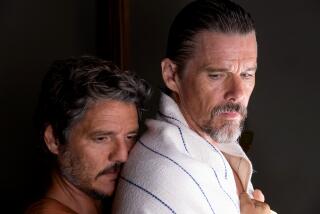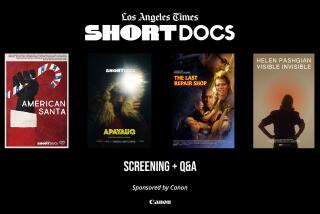Thaw in U.S.-Cuba relations stuns ‘Alumbrones’ filmmakers
When the U.S.-based filmmakers of the documentary “Alumbrones” traveled to Cuba two years ago to profile a group of artists from Havana, they had no idea about the changes in store for the two countries by the time the movie would be released.
“I was extremely overwhelmed,” director Bruce Donnelly said shortly after the announcement that the two countries would restore diplomatic relations after more than five decades of hostility. “It’s an opportunity for lives to change ... It’s definitely going to be a struggle — it will probably take generations for things to get back on their feet.”
“Alumbrones,” which opens in Los Angeles on Jan. 16 and will also be available on iTunes and other online platforms, is a modest documentary consisting of interviews with 12 artists living in and around the Cuban capital. (The movie’s title is Spanish for “Illuminations.”)
Taking a low-key, understated approach, the documentary not only explores the creative lives of its interviewees but also the economic realities of being an artist in an isolated Communist dictatorship.
For example, “Cuban people are constantly recycling,” said printmaker Eduardo Guerra in the movie. “The very economic need leads people to accumulate things — objects, medicine, food. That’s a recurring theme in people’s lives, the lack of objects and things.”
The lack of online connectivity also weighs on some of the artists. “We don’t have Internet,” said Raimon Rodriguez Moya, a young artist and recent art school graduate, in the movie. “It would be a privilege to have Internet access. We would be able to see so much more. That’s something affecting Cuban art.”
“Alumbrones” was shot over four months in 2012. The movie has been shown at festivals around the world and was released in New York in September, but the filmmakers said the movie has yet to be seen in Cuba outside of a private screening for friends.
When President Obama announced in December the restoration of full diplomatic ties with Cuba, producer Fermin Rojas said he called several of the documentary’s subjects to break the news.
“They were all very happy about it,” he recalled. “I think it’s still going to be a long road going forward. But I think they’re optimistic.”
Rojas was born in Cuba and fled the island nation with his family in 1966 at the age of 6.
“When you reached a certain age in Cuba, you had to participate in certain institutions, and there was a chance you would be sent away from your family, and away from your city,” he said. “I think my mother was afraid to have her children removed from her. I remember that was the main reason we came to the U.S.”
The family eventually settled in Miami Beach. Making the documentary allowed Rojas to return to the island nation for the first time since fleeing.
To shoot in Cuba, the filmmakers obtained filming permits and other paperwork through a Canadian company, Cuba Film Productions, since there were no organizations in the U.S. that could make such arrangements.
They said that they experienced no difficulties shooting in Cuba and that post-production took place in Brazil. The micro-budgeted documentary cost approximately $150,000, according to director Donnelly, who hails from South Africa and is based in New York.
There have been many foreign documentaries shot in Cuba over the years, including the music-themed “Buena Vista Social Club,” directed by Wim Wenders, in 1999, and the more overtly political “Comandante” and “Looking for Fidel” from director Oliver Stone in 2003-2004.
Michael Moore’s controversial 2007 healthcare documentary “Sicko” was also shot partially on the island nation.
The number of U.S. productions seeking to shoot in Cuba is likely to increase following Obama’s December announcement, according to Cuba Film Productions. Two U.S. projects shot in Cuba are already underway — “Cuban Chrome,” a reality TV series from the Discovery Channel, and a feature film titled “Papa,” about Ernest Hemingway.
“American productions have never been prohibited by the Cuban government to film on the island. It is the U.S. government that has placed restrictions on its own filmmakers from filming in Cuba,” a company representative said in an email statement.
The makers of “Alumbrones” have already begun work on another documentary shot in Cuba about a gay men’s jazz ensemble.
“It had no problems getting approved,” said Fermin, who is producing the new film. “We have not hit any snags at all.”
Twitter: @DavidNgLAT
More to Read
The biggest entertainment stories
Get our big stories about Hollywood, film, television, music, arts, culture and more right in your inbox as soon as they publish.
You may occasionally receive promotional content from the Los Angeles Times.







